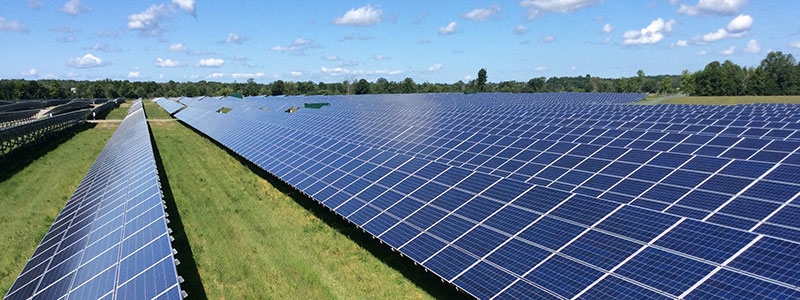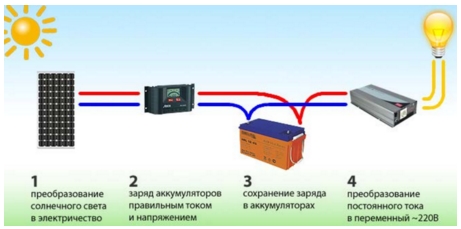
Nuclear power plants, combined heat and power plants, diesel, gas stations - all these facilities refer to traditional energy. They work at the expense of natural resources. After burning, splitting or using them, electrical energy is received and transmitted with the help of turbines, generators. Since the consumption of electricity only grows every year, and the natural resources are depleted and cannot be restored, the problem of replacing traditional production methods with non-traditional ones appears. Both traditional electric stations and plants, alternative systems need grounding and lightning protection to ensure the safety of personnel and protect expensive equipment from natural phenomena.
The use of alternative technologies for the production of electricity has become widespread not only in industrial, but also in domestic conditions
Types of alternative systems for electricity generation
Electricity can be obtained from the energy of wind, sun, tides, by burning biofuel and even from a lightning strike! For that, wind, solar, tidal and many other power plants are being made.
Particular attention will be paid to solar electric or as they are called - "photogalvanic" and "photovoltaic systems" (PVS), as the most popular among ordinary citizens.
What is the solar electrical system, what other names does it have, where are they used
PVS can be either a large power plant that provides electricity to the electricity mains, or a small installation that can be installed in the country house for autonomous power.
The main components of the FES, as shown in Figure 1, are:
- photovoltaic panel (solar battery);
- controller;
- Battery - not necessary in the stations that provide electricity to the mains;
- inverter (DC to AC converter).

Figure 1 - Basic Elements of PVS
Преобразование солнечного света в электричество – conversion of sun light into electricity
Заряд аккумуляторов правильным током и напряжением – charging of accumulator batteries by correct current and voltage
Сохранение заряда в аккумуляторах – preservation of charge in accumulator batteries
Преобразование постоянного тока в переменный – conversion of DC to AC
Possible risks associated with electrical engineering
As in any electrical system, there are risks associated with some external or internal factors. External hazards include a direct lightning strike, damage from which is inevitable, or accumulated static potential, dangerous to humans. Among internal threats, we can note a short circuit, which can result in a sudden voltage surge, which in its turn is dangerous for equipment and wiring, not to mention human.
The equipment used in the PVS costs a lot of money, so it is advisable to follow the electrical safety rules and apply appropriate protective measures for grounding and lightning protection, both external and internal, to prevent the above-mentioned risks.
Solutions for protecting photovoltaic systems
Grounding
In Russia, the regulatory documents that establish specific requirements for a grounding device (GD) for PVS haven't been yet developed. In this case, in order to properly organize the grounding device, it is necessary to take into account the requirements contained in the current regulatory document - EIC-7. Depending on the grounding system, which is used at the facilities, the requirements for ground resistance are determined.
Paragraph 1.7.101 determines the requirements for the grounding of the generator neutral resistance - 4 Ω for 220/380 V a of single-phase / three-phase system.
In the IT system, according to p 1.7.104, the resistance should also be not more than 4 ohms. However, for installations with a power of less than 100 kVA, an increase in the norm of up to 10 ohms is permitted. For installations with more than 1000 V, which generate electricity for large objects or even cities, the required resistance is 0.5 Ohm. In this PVS, the zero conductor appears after the inverter, in which the DC is converted to AC. The inverter, photomodules and controller must be grounded directly from the main ground bus (MGB). In the input switchboard, a residual current device (RCD) must be installed to avoid current leakage in case of wiring damage. If the object is large enough, then an additional system of equipotential bonding must be provided.
The necessary parameters of the grounding device (the design, the length of the electrode) depend strongly on the soil resistivity. In addition to low resistance, the grounding device must also be durable to ensure the uninterrupted operation of the solar power plant throughout its life.
Today, there are special requirements to ground electrodes (GOST R 50571.5.54-2013), namely to the materials from which they are made. This is due to the fact that many of the previously used materials are strongly corroded. The most durable are copper, copper-plated and stainless-steel ground electrodes.
To achieve the necessary grounding parameters in ordinary soils, it is rational to use modular grounding, which will allow to achieve positive result without excessive efforts and wasting of time.
External lightning protection
Photoelements are mostly installed in open areas in order to have maximum access to solar radiation. Very often these are the roofs of buildings, houses, open fields, etc. Such places are exposed to an increased risk of lightning, which means that expensive equipment can be damaged!
The protection of the PVS from lightning is carried out on the same principle as any other object. To begin with, it is necessary to determine to which class of lightning protection the object, on which the photomodules are installed, belongs. If photoelements are installed on the site, they can be classified as lightning protection of category II or III, depending on the design and purpose. After that it is necessary to calculate the protection zones in accordance with regulatory documents AD 34.21.122-87 and IS-34.21.122-2003.
First of all, the phomodules installed in the open area are exposed to the danger to be struck by lightning. Therefore, to protect solar panels from direct lightning strikes, rod or catenary wire lightning rods, that provide the necessary protection zone, are used.
The type of protection of photopanels is determined on the basis of economic considerations, since they are not the most expensive components of the system. In case when the panels are installed on the roof of the facility, it is rational to perform lightning protection of the building taking into account the location of the photomodules, whic at the same time "kills two birds with one stone". If we are talking about a large solar station installed in an open area, where all inverters, controllers and other expensive equipment are inside the building, then protection of the solar panels themselves from a direct lightning strike foresees a deep analysis of thunderstorm activity in the area, cost of works and equipment. It is also necessary to resort to the system of potential equalization, since the PVS can consist of a large number of elements.
Protection from lightning is protection against physical damage, which is IMPORTANT! However, much more important is the protection of inverters and controllers from the secondary effects of lightning strikes, which make up most of the cost of the entire system!
Surge protection
Power from the electricity mains can be dangerous due to power surges, as a result of accidents or lightning strikes into the power line. These problems did not disappear in the alternative systems, therefore, all measures of protection against the secondary effects of thunderstorms need to be taken into account, since in addition to all equipment in the house, internal components of the solar power plant may suffer.
In addition to the organization of external lightning protection systems of a temple, one should not forget about the provision of internal lightning protection systems: SPD, RCD, APS, etc., since the failure of the power supply system leads to a shutdown of life support systems, such as fire fighting and alarm systems, ventilation and air conditioning, etc.
To provide internal protection against surge voltages, it is necessary to determine the main installation locations for surge protection devices (SPDs). In such systems, it is the input to the controller from the photomodules (DC) and the output from the inverter (AC), also when using power from the mains, it is necessary to install an SPD at the input to the main switchboard.
To protect the DC network, SPDs of the voltage from 48 V to 1 kV are used; AC (at the output of the inverter) - SPD of 2 class, depending on the grounding system of the object; from the side of the mains, the universal SPD of Class 1+2+3 are recommended for use.
Examples of using protective measures
Every year, the number of PVS only increases, the relevance of alternative energy is confirmed by the world community. The cost of such systems can range from several thousand to several million rubles. Therefore, it is strongly recommended that in the design of such installations, special emphasis should be placed on lightning protection and grounding of these objects in order to avoid damaging the costly components of the system and the cost of work.
In today's world, there are many solutions to protect photovoltaic power plants of any power in any conditions, even in Antarctica. A ground electrode based on the kits of electrolytic grounding for permafrost and rocky soils will allow achieve the required resistance of the grounding device!
Specialized software and engineering programs allow you to accurately calculate the reliability of the system, select the necessary design of a grounding device and lightning protection, achieve the required ground resistance and thus protect expensive systems.
See also:
- Lightning protection and surge protection of solar panels
- How to perform grounding of a transformer substation?
- What is a disspation array device and how it works?
- Useful materials for designers: articles, recommendations, examples
- Soil resistivity table
Related Articles:



